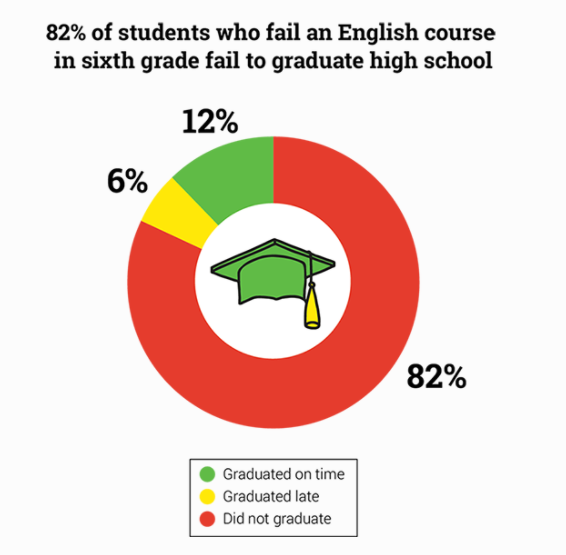Sixth Grade Struggling Readers
As noted previously early elementary reading performance has a key role in high school graduation rates. Middle school reading performance is even more critical to graduation rates. A study by Balfanz and Herzog (2007) of almost 13,000 students found that only 12% of students who failed an English course in sixth grade graduated from high school, and the other 6% graduated late. 82% did not graduate!
Fifth and Sixth grade are part of a period during which reading gains experience the biggest decline. During the course of a student’s education, yearly reading gains typically decrease as they move through the grades, which is expected and a normal pattern of cognitive development. Students typically experience large reading gains in the early years and then those gains diminish as the student moves through the normal grade progression. For example, the difference between a student’s reading skills in first grade and third grade is much greater than the difference between skills in tenth and twelfth grades. However, the rate at which reading gains slow is not steady across all years.
If you look at only the changes in typical Lexile reader measure ranges across the years, a different pattern emerges. We do not see a steady decline, but instead an incredibly steep drop at the fifth and sixth grades.
For most grades, the increase in both the upper and lower boundaries is 80% to 100% of the prior year’s increase. However, between fourth and fifth grade the increase drops to 61% for the lower boundary and 68% for the upper boundary, and between fifth and sixth grade the increase drops to 63% for the lower boundary and 65% for the upper boundary.
Based on studies by Renaissance Learning, it is at the sixth grade that students stop independently reading books within the text complexity bands for their grade. Between second and fifth grades, the vast majority of students read at least one book in their target grade band. In sixth grade, that number plummets below 20% and never really recovers. From sixth grade through high school, less than 15% of students, on average, read one or more books in their target range.
How do we reverse these trends? Consider the possibilities if these trends were reversed! Adding just a few additional minutes of daily reading practice can help struggling readers transform into successful readers, perhaps this could also help change all students’ academic trajectories?
Perhaps simply challenging our 5th and 6th graders with more complex books and material could create much stronger readers and students in the later years?
To help meet this need The Reading Ranch has developed The Critical Analysis and Reasoning (CARs) course for 5th and 6th students. The CARs course offers an in-depth approach to mastering comprehension, exploring analysis, reflection, argument, and reasoned decision making using a logic-based approach. The course helps broaden vocabulary, develop critical thinking skills, and help challenge the student using these critical skills.



